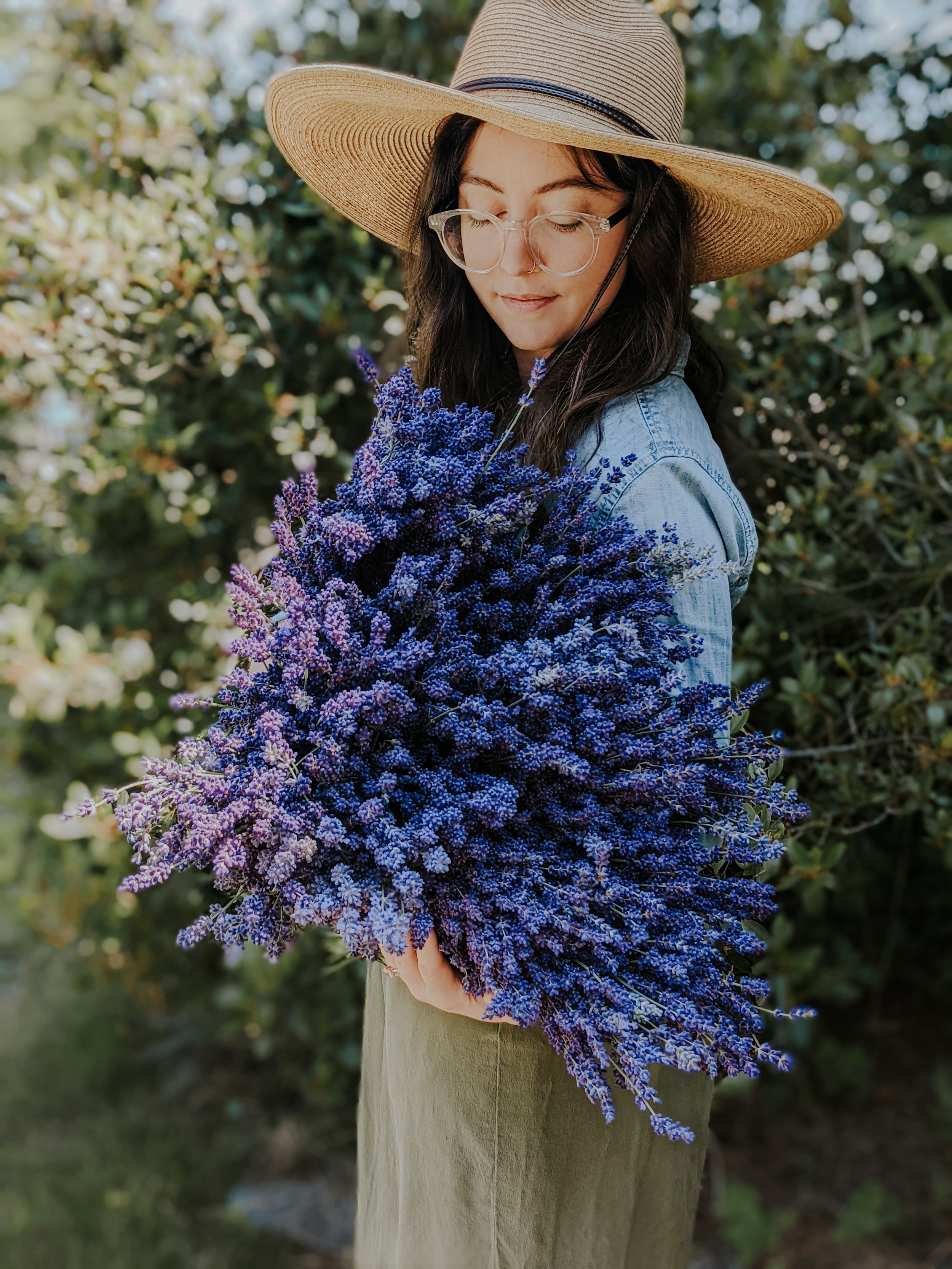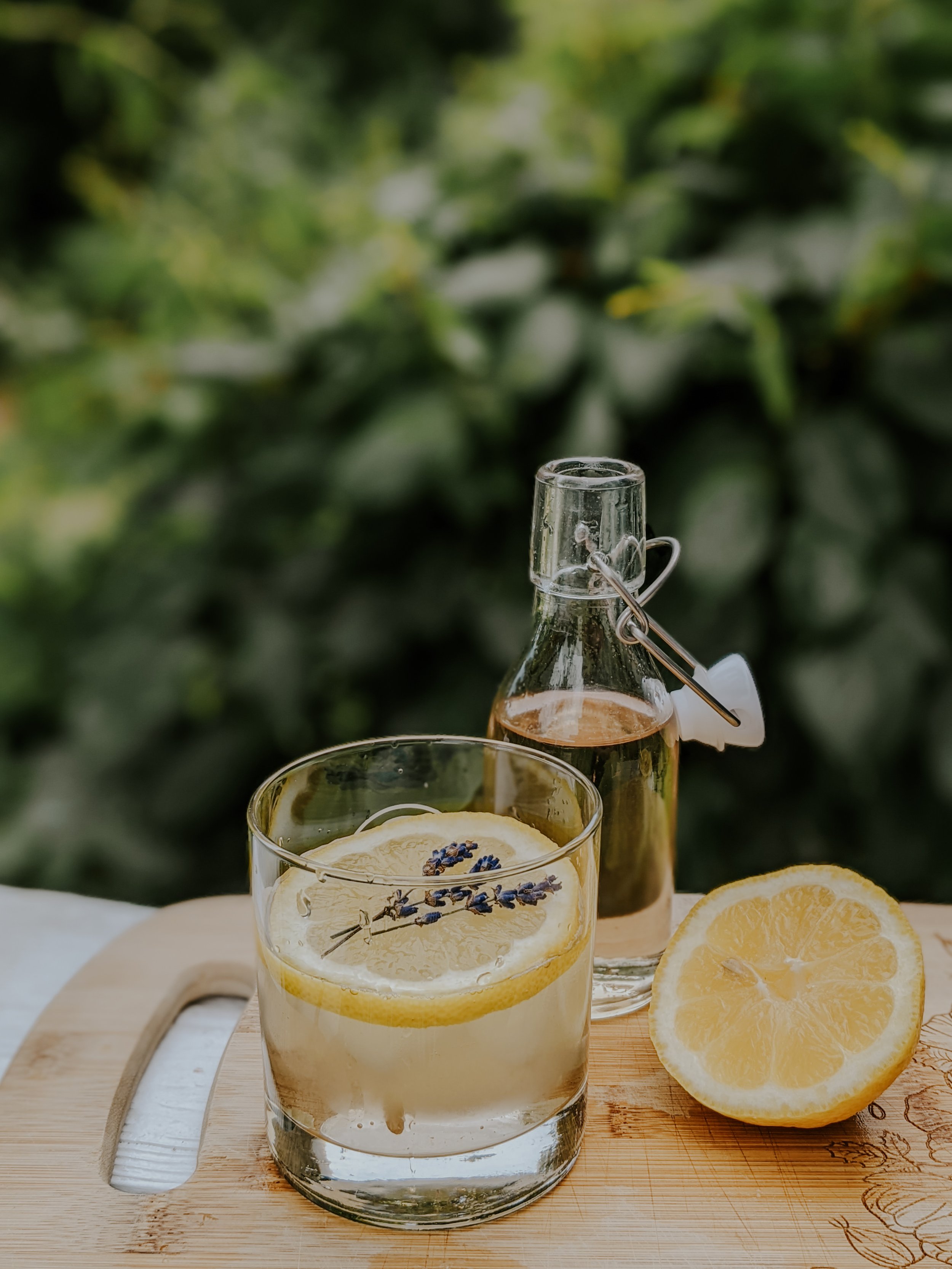BACKYARD GARDENING MADE SIMPLE
Benefits of Lavender and How to Grow Your Own
Lavender is beautiful, but that’s only one of its many benefits. Its soothing scent makes it a much-loved ingredient in soaps, sachets, lotions, eye pillows, and shampoos.
The aroma itself comes from oil in the small flowers, which grow together on long stems above the silver-green foliage. Lavender essential oil has been studied for a variety of potential medicinal uses, including preventing hair loss and reducing agitation in people with dementia. Its antiviral and antibacterial uses are also being studied.
The Cottage Peach is reader-supported. When you purchase through links on our site, we may earn an affiliate commission at no additional cost to you. All opinions are our own.
Since we grow more lavender than any one family needs, we’ve found just about every way possible to enjoy dried lavender around here. Recipes and gift ideas are below, but first let's talk a little about why I love lavender so much!
What are the benefits of lavender?
Lavender is beautiful, but that’s only one of its many benefits. Its soothing scent makes it a much-loved ingredient in soaps, sachets, lotions, eye pillows, and shampoos.
The aroma itself comes from oil in the small flowers, which grow together on long stems above the silver-green foliage. Lavender essential oil has been studied for a variety of potential medicinal uses, including preventing hair loss and reducing agitation in people with dementia. Its antiviral and antibacterial uses are also being studied.
Lavender has traditionally been used medicinally for insomnia and anxiety due to the sedative effects of its aroma. It is frequently used to fill pillows in order to encourage sleepiness, and strewn in water to make a hot bath even more relaxing.
I've been using lavender to soothe my anxiety since I first sprayed a lavender scented room spray on my pillow as a teenager. Now I like to put a few drops of oil on my hair scrunchie when I'm feeling stressed, and keep a bundle on the windowsill beside my bed for sweet dreams.
How to Use Lavender for Aromatherapy
Want to know the secret to a soothing shower? I bet you won’t be surprised when I say lavender. Simply bundle some stems of dried lavender and tie them together with a length of twine. Make a loop with the end of the twine, which you can drape over your showerhead.
This simple, beautiful, natural decor item will bring a sense of peace to your home. Bring your lavender in the shower with you - I promise you won’t regret it!
Alternatively, dried lavender can be mixed with Epsom salts in a bath.
Lavender will make your bathroom a retreat in which to relax, calm, and soothe not only your mind but your skin as well.
Lavender-Infused Sugar Recipe
Add a handful of dried lavender buds to a cup of sugar. Store it in a cabinet or on the counter in a pretty mason jar - I love these wooden lids you can put on Ball mason jars. Lavender-infused sugar is a delicious addition to tea, cookies, or pound cake.
Lavender Simple Syrup Recipe
My favorite thing to do with our homegrown lavender by far is to infuse it into a simple syrup. This syrup can then be used to make mocktails (see recipe below), popsicles and many other desserts. You can make your own lavender simple syrup for drinks and desserts at home in just a few minutes!
Ingredients and supplies:
1 Tablespoon lavender buds
1 cup sugar
1 cup water
A sieve or cheesecloth
A leak-proof jar
Directions:
In a small pot combine the lavender, sugar, and water.
Bring the mixture to a boil, then let it boil for one minute.
Remove the pan from the heat and steep the syrup for one hour before straining.
Strain with the sieve or cheesecloth.
Pour into an airtight jar and store in the refrigerator.
This simple syrup keeps well in the fridge for about 3 weeks, but don’t worry - you’ll finish it long before it has a chance to go bad!
Lavender Lemonade Summer Mocktail Recipe
Summertime drinks are just more refreshing when fresh fruit, herbs, and flowers are added. This Lavender Lemonade Mocktail recipe is a favorite. Just don’t ask me how many glasses of this I’ve enjoyed over the past summer - it’s more than I care to admit!
Ingredients:
1 oz lavender simple syrup (see recipe above)
1 oz lemon juice (fresh-squeezed is a must!)
1 oz sparkling water or seltzer (tequila would work too)
A slice of lemon
2 small sprigs of lavender
Directions:
Combine simple syrup, lemon juice, and sparkling water in a glass with plenty of ice. Top with a slice of lemon and the lavender sprigs and enjoy!
DIY Lavender Sachets
Lavender sachets are super useful in drawers and cupboards where clothes are kept, as they will both keep your clothes smelling fresh and deter moths. Consider placing one between each of your wool sweaters for extra protection.
Supplies:
Fabric scraps (Thinner fabric is best, to allow the scent to easily diffuse. Quilter’s cotton works well.)
Needle
Thread
Dried Lavender buds
Directions:
Sew fabric scraps into small squares or rectangles, with the fronts of the fabric facing each other. Leave one side open. Turn right-side out and stuff with dried lavender flowers, then finish sewing it closed. Alternatively you can use hem tape for a no-sew version.
How to Grow Your Own Lavender
Of course, these five ideas for using lavender are even more fun if you grow your own! Lavender is native to the Mediterranean, so it prefers a hot, dry spot. It isn’t picky as to soil type, and will grow just fine in a rocky or sandy area.
Lavender plants are quite easy to care for, and don’t need fertilizer or supplemental watering. To make the treats above, be sure to plant an edible variety.
We like to grow Hicote and Munstead lavenders, both of which are English varieties. Hidcote has dark purple flowers which form tightly, while Munstead has lighter flowers that are more loose and open. Our favorites are the Hidcote, as the color is deep and doesn’t fade much, if at all, when it is dried, but combining the two makes for a beautiful garden bed and bouquets.
How to Prune Lavender
Lavender wants to grow into a woody and not very attractive plant, so it’s important to trim it twice a year, once when the first flush of flowers is ready for harvest, and again in the fall to prepare them for winter. After the first pruning of the year, they will bloom again, although the harvest won’t be as thick or showy.
I think of this pruning as giving the plants a haircut. You don’t want to give them a buzz cut, removing all of the green leaves. Instead, leave two or three inches of green growth on each stem.
Keeping up on this pruning twice a year will ensure your plants maintain a pleasing shape and prevent the stems from hardening. Once a lavender plant becomes woody, it won’t produce well and you’ll likely want to replace it.
How to Harvest and Cure Lavender
The key to long-lasting dried lavender is the timing of the harvest. Through years of research, trial + error, I’ve learned the optimal time to pick each bloom so the dried flowers are less likely to fall from the stems, and the scent will not quickly fade away. It’s best to harvest lavender early in the day, while it’s cool but the sun has been out long enough to dry any remaining dew, and just before the flowers have completely opened.
I count down the minutes until I can pluck each stem from its plant and bring it into our home. For weeks after the lavender harvest, our whole house smells like sweet lavender, and peace prevails.
When the time came for our latest harvest, I made my way outside as the sun was just beginning to peek over the horizon, and I experienced a really beautiful moment. I looked up and the moon was still high overhead, and at the same time the morning sun warmed my face. Having both the sun + moon to keep me company was more than enough, but then I heard a rustle beside me and when I turned, I saw the most peaceful bunny eating breakfast. We coexisted together while I finished my work and then went our separate ways.
You will find that a lavender bed is full of bumble bees just about any time you look at it. Sometimes they try to hitch a ride on the cut flowers! Lavender attracts all sorts of beneficial insects.
To harvest, I gather bunches of stems with one hand, and cut each bunch all together, being careful to keep the stems as long as possible. I find Felcos to be the best tool for the job. A Hori Hori garden knife is also effective, but tends to leave the plants looking a tiny bit shaggier and not as neatly clipped.
While still outside, I separate the harvest into bouquets which I bind with a strong elastic to dry. The elastic works best for drying because the bundles will shrink as the moisture evaporates making twine too loose.
Curing locks in the unmistakable scent we all know and love so well. Our bouquets hold their scent for more than a year - you can re-activate it by giving the bouquet a gentle squeeze to release more essential oils! Just do this over a sink as some buds will fall off.
This curing process is essential to your bouquet carrying the smell of lavender through your home for many months to come. Over weeks we watch the buds pulling closer together and feel the stems turning crisp under our fingers. It can be done very simply by hanging the bundles by loops in their twine on a folding laundry rack or even your curtain rods.
One fully dried, a flurry of commotion results at my kitchen table as bundles are wrapped with twine. Now our bouquets are fair game for all of the above uses and more.
What is your favorite way to use lavender?







